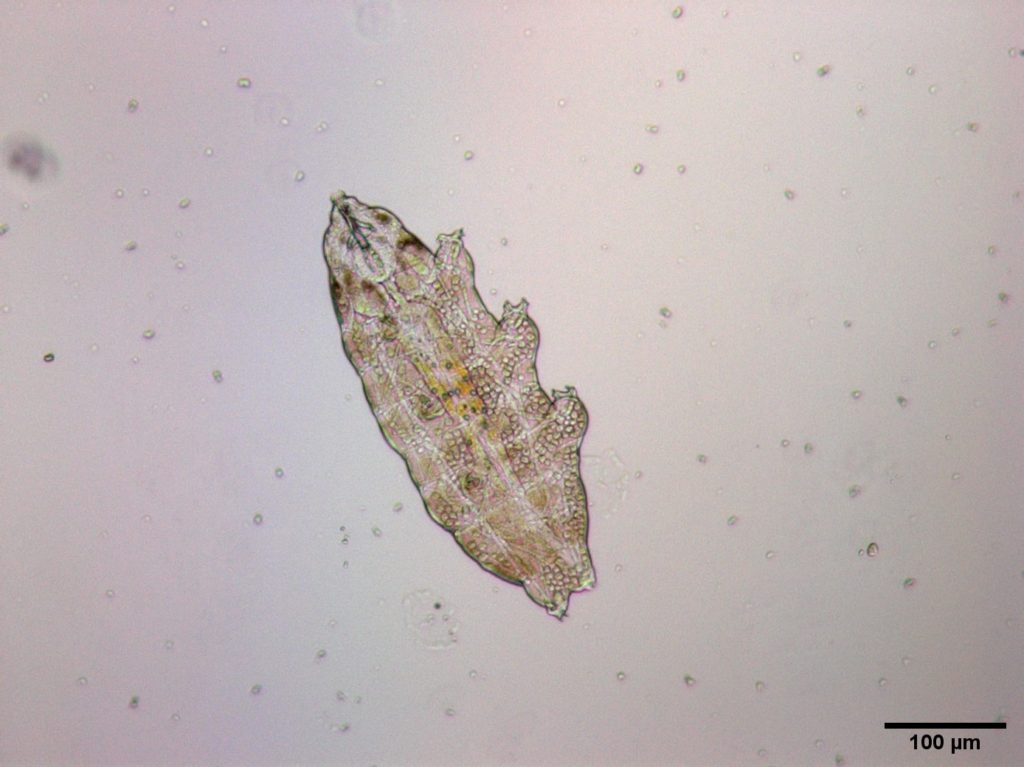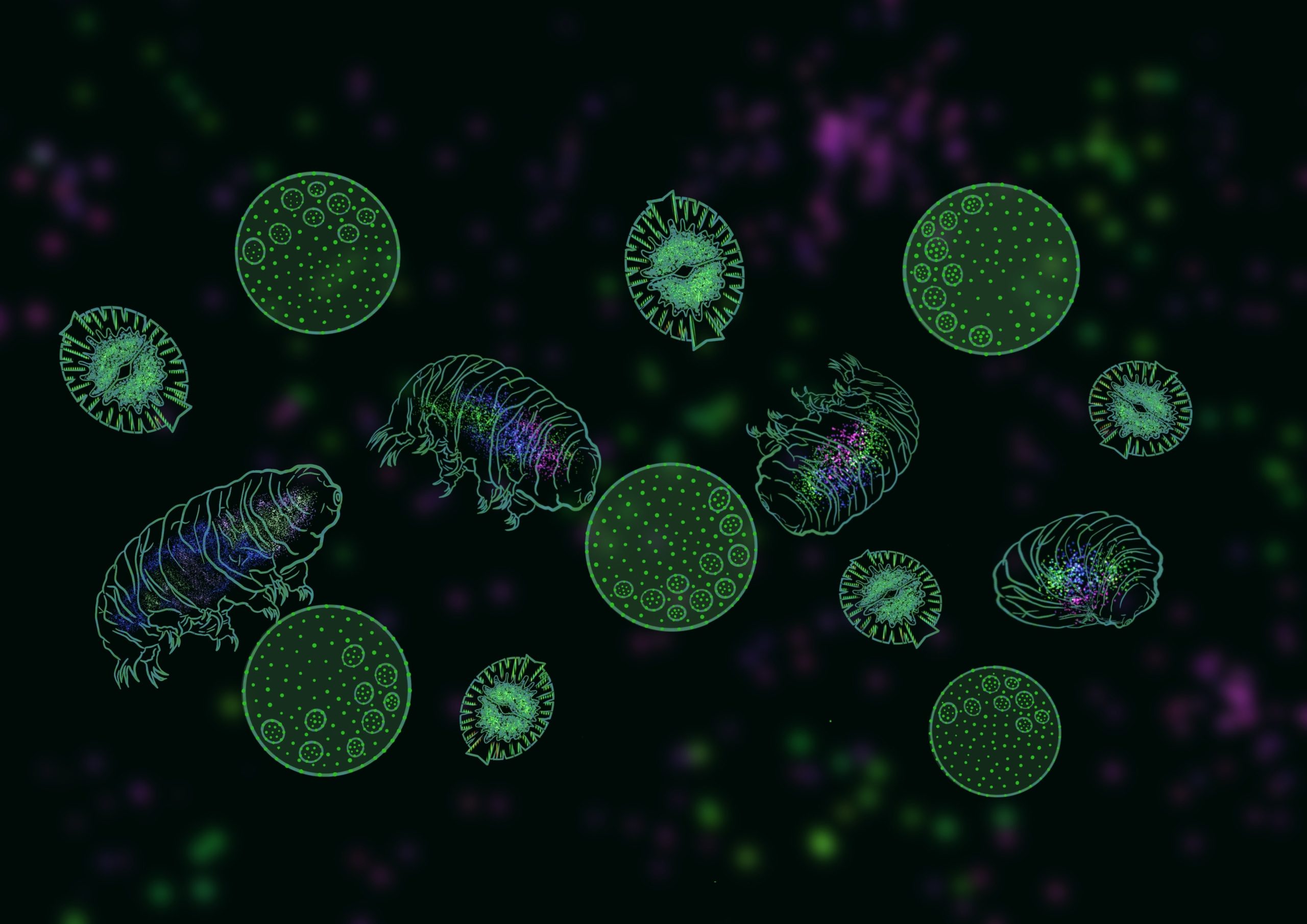Tardigrades are beloved microorganisms. These little water bears hide in moss, lichen, and bark of trees. When kids discover tardigrades, it often sparks an interest in science. If you haven’t personally experienced finding a tardigrade under the microscope, I promise it makes a significant impact.
In this podcast episode, you’ll get the chance to learn about tardigrades from Dr. Sandeep Eswarappa, who studies these delightful organisms in his laboratory. After listening to the interview, you’ll see that he has a clear passion for the microbial world. So, you’re sure to enjoy this episode of the podcast. Whether you can listen to the interview or not, keep reading to learn some of the takeaways.

Topics covered in this episode:
- What are tardigrades?
- Where can you find tardigrades?
- What other organisms live in the same places as tardigrades?
- What do tardigrades eat?
- Tardigrade life stages
- Are tardigrades immortal?
- Applications of tardigrades survival in extreme conditions
- At-home microbiology activity: Watch tardigrades emerge from tun to active state
Listen to my episode with Dr. Sandeep Eswarappa
.redcircle-link:link {
color: #ea404d;
text-decoration: none;
}
.redcircle-link:hover {
color: #ea404d;
}
.redcircle-link:active {
color: #ea404d;
}
.redcircle-link:visited {
color: #ea404d;
}
Powered by RedCircle
Or listen on Apple Podcasts, Google Podcasts, or Spotify
What are tardigrades?
Tardigrades are microscopic animals that measure around 1 millimeter or less. “To give you an idea, it’s about the thickness of five human hairs or the tip of a pencil, barely visible with the naked eye. But with a simple microscope, we can visualize them,” says Sandeep.

Where can you find tardigrades?
They live in places with moisture, so they are considered limnoterrestrial. You might find them on tree bark, moss patches, lichens, or wet soil. If you take a sample from these locations and observe that under the microscope, there is a chance you will find tardigrades. Learn how to find a tardigrade at home under the microscope here.
What other organisms live in the same places as tardigrades?
Other organisms share the same habitats with tardigrades, including rotifers, nematodes (tiny worms), and other unicellular organisms like ciliates.
What do tardigrades eat?
Some tardigrades are herbivores and eat algae; some are carnivorous and eat nematodes. “We have a couple of videos of them eating worms, like noodles. They’re just sucking the worms into their mouths, like a string of noodles. It’s fascinating to watch,” Sandeep tells me.
Tardigrade life stages
Tardigrades go through three life stages: eggs, adults, and tun. In the egg stage, development happens. Once development is complete, the adult emerges from the egg. They’re happy with the proper environmental conditions, like ample food, warm water, and the correct pH. You’ll see them feeding and walking around, which is fun to watch, says Sandeep.
But in the face of stress, like slow dehydration or an increase in pH, they will start to shrink into a small ball, about 1/3 of the adult size. That state is called tun state. “You can imagine them as seeds of tardigrades,” says Sandeep. “All of their physiological processes are on pause, allowing them to be in a highly resistant state to live through most physiological stresses, such as extreme radiation and extreme temperature.
However, it’s important to keep in mind that not all tardigrades can withstand all types of stress. “I’m not saying one tardigrade is resistant to all of them,” says Sandeep. “But you can always find a tardigrade which is resistant to any of the given physical extreme conditions.”
The transition between active adult to tun state and back to active adult is something Sandeep has actually watched occur in his lab. “We have done it a few times, especially whenever a new trainee comes to work on tardigrades, that the first thing they do. It kind of motivates them to do more research.”
When tardigrades are in the tun state, it takes about 30 minutes after exposure to water to start expanding and moving. However, going into the tun state takes much longer, about 24 hours in the lab. The process must be gradual, though, because if you remove water immediately, they will die. They need time to reprogram their physiology to stay viable in the tun stage. It’s how it happens in nature, after all. Moisture in a patch of moss slowly disappears during dry periods. Then, rain comes and wakes them up, says Sandeep.
Are tardigrades immortal?
With the ability to survive extreme conditions, you might wonder if tardigrades are actually immortal. The short answer is no. They are mortal like any other form of life. In fact, they can live and reproduce for usually a few months in the active adult state. But then, they become weak, less mobile, and stop moving, at which point they die.
But in the tun state, tardigrades are more resistant to harsh conditions and can live for much longer than in the active state. How long can tardigrades live in tun state? It varies from species to species, says Sandeep, but researchers have reported finding tardigrades that survived in tun state for 30 years.
Applications of tardigrades survival in extreme conditions
Because tardigrades can survive these harsh conditions, scientists are studying them to understand how they do it so we might harness these traits. “We found that one of the tardigrade species was resistant to UV because of the autofluorescence it has,” says Sandeep. “And one application I can think of is if we identify the counterpart which is responsible for the fluorescence, that can act as a very good sunscreen agent, which can protect us from sunburn.”
Also, Sandeep mentioned that their ability to resist extreme radiation means tardigrades can repair their DNA very effectively. So, once we understand how they do it, we might be able to use that knowledge to develop anticancer therapies.
At-home microbiology activity: Watch tardigrades emerge from tun to active state
This activity takes the “find a tardigrade” activity to the next level. Here, you get to observe tardigrades coming out of their dormant tun state and returning to active state.
- Go outside, collect some moss, lichen, or tree bark, soak it in water, prepare it for the microscope, and find a tardigrade. See this post for the complete directions.
- Let the slide dry out so that all of the water evaporates. (Let this happen over a few days because the tardigrade needs time to alter its physiology for the tun state.)
- Once it is dry, go back to the microscope, add a drop of water to the slide, and observe your tardigrade again.
- Watch for about 15 to 30 minutes as the tardigrade returns to its active state, wiggling, stretching, and moving its limbs.
“If you’re watching it for the first time, it will be remarkable,” says Sandeep. “You will never forget it. It’s like a dead man coming back to life.”
Links & Resources
This post contains affiliate links — see my disclosure policy.
- How to find a tardigrade at home under the microscope (blog post)
- Microbe Hunters by Paul de Kruif (book)
- Water Bears: The Biology of Tardigrades by Ralph O. Schill (book)
- Emerging field of tardigrades and their stress tolerance (article)
- The Hidden Beauty of the Microscopic World by James Weiss (book)
Connect with Sandeep M. Eswarappa
Dr. Sandeep M, Eswarappa is an Associate Professor at the Indian Institute of Science, where he studies tardigrade mechanisms of resistance to extreme stress and translation regulation of gene expression.
Connect with Dr. Sandeep Eswarappa: Twitter, website
Special thanks to Guadalupe Manrique-Maldonado for the wonderful tardigrade graphic at the top! Check out her Instagram account here.
The post What is a tardigrade? appeared first on Joyful Microbe.


